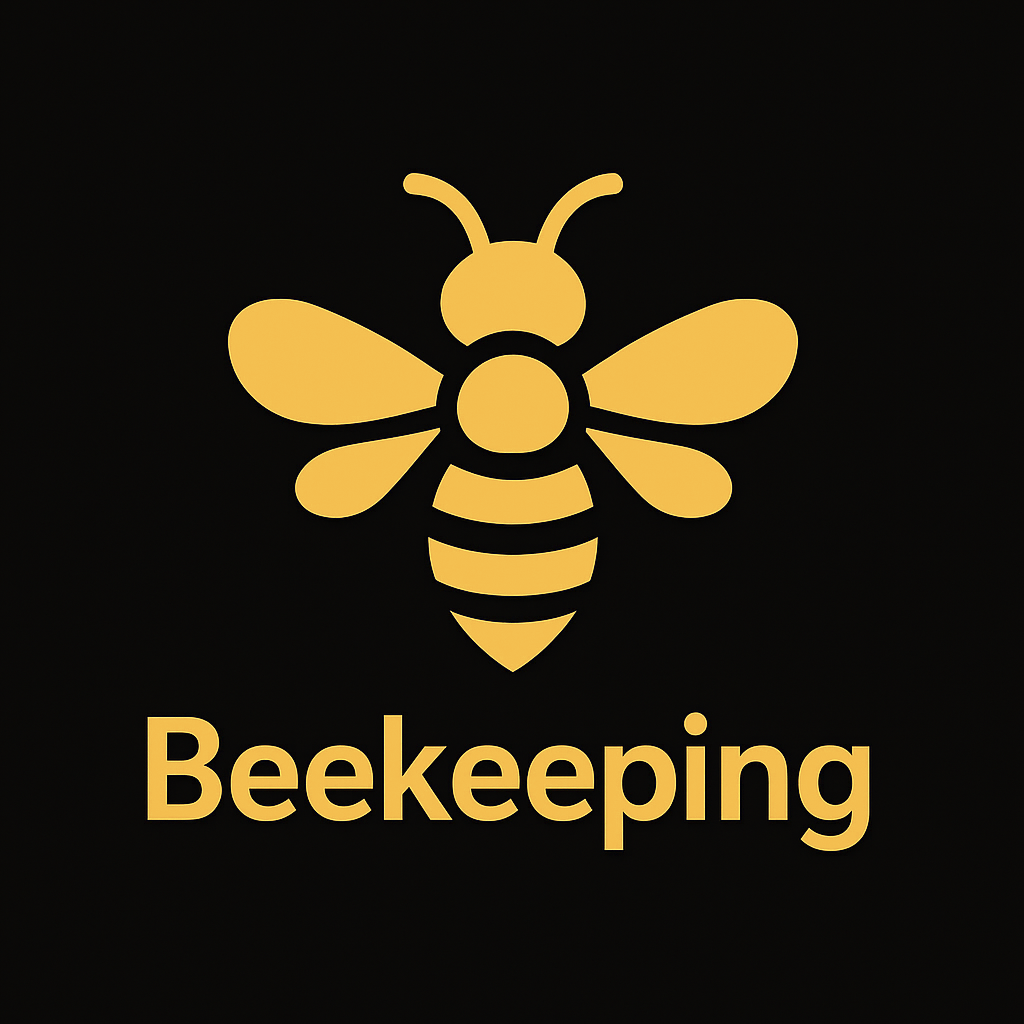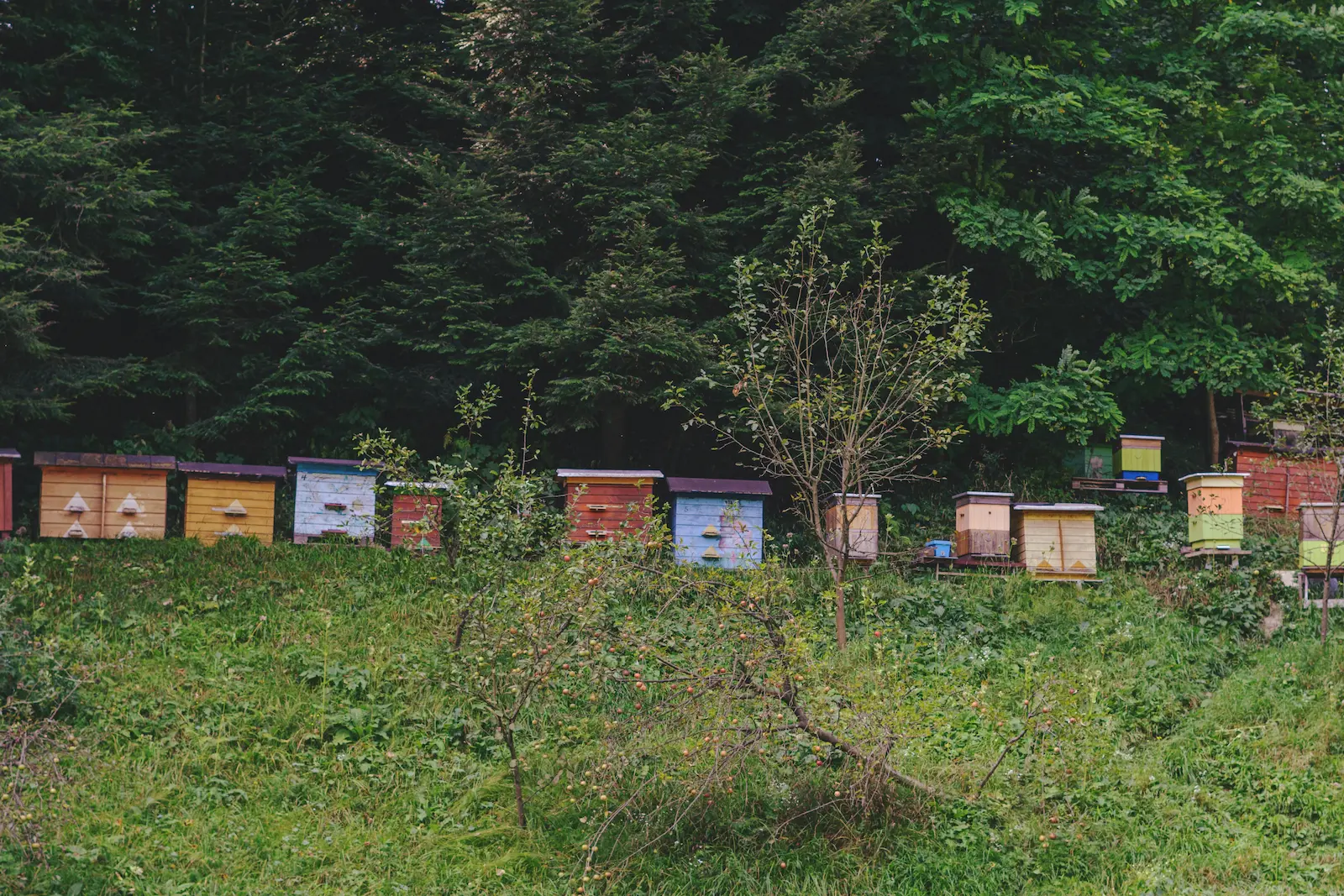How Bees Make Honey – From Nectar to Capped Stores
Watching bees flying back and forth with full pollen baskets is one thing – understanding how they turn thin, floral nectar into long-lasting honey is another. This guide explains the honey-making process step by step, in plain language, with just enough science to help you make good decisions in the apiary.
Quick overview: how honey is made
Honey making is a team effort. Forager bees collect thin, sugary nectar from flowers and carry it home in a special honey stomach. Inside the hive, they pass this nectar to house bees, which mix it with enzymes and spread it out in shallow wax cells. Worker bees then fan their wings to evaporate water, thickening the nectar into honey. Once the moisture is low enough and the honey is stable, they seal the cells with wax cappings for long-term storage.
Every part of the colony plays a role in this process. If you’d like a refresher on the different castes and body parts involved, take a look at Honeybee Anatomy and Honeybee Behaviour.
Step-by-step: from nectar to sealed honey
1. Forager bees collect nectar
The process starts with forager bees. Guided by their sense of smell, colour vision and information from the waggle dance, they search for flowers rich in nectar. Using their long, flexible tongues (proboscis), they sip nectar from the base of the flower and store it in a dedicated honey stomach (crop), separate from the digestive stomach.
On a good forage day, a single forager may visit hundreds of flowers. Along the way she also picks up pollen, contributing to pollination and helping plants set fruit and seeds in the wider environment.
2. Enzymes begin the transformation
Even while the bee is still flying, the nectar is not just sitting there. It is being mixed with enzymes such as invertase, which begin breaking down complex sugars (mainly sucrose) into simpler sugars (glucose and fructose). This is one reason why honey is easier for bees to digest and has different properties from nectar.
3. Trophallaxis – nectar handover in the hive
Back in the hive, the forager passes the nectar to a house bee via trophallaxis – a mouth-to-mouth transfer. This is a key social behaviour in the colony. The exchange:
- spreads nectar around multiple bees,
- adds further enzymes, and
- helps equalise the composition of nectar from many different flowers.
Some of this nectar may be consumed quickly to fuel flight and brood rearing. The rest is destined to become stored honey.
4. Spreading nectar in comb cells
Once processed by house bees, the nectar is deposited as small droplets inside open hexagonal cells of the honeycomb. At this point it is still a thin liquid, often containing around 70% water, which is far too high to be stable long term.
By spreading the nectar into a thin film across the walls of the cell, bees dramatically increase the surface area, making evaporation more efficient. The comb itself acts like a drying rack.
5. Evaporation – bees fan the hive
Worker bees line up at the entrance and around the comb, fanning their wings to create strong air currents through the hive. Warm, moist air is pushed out and replaced with drier air from outside. This:
- removes excess water from the nectar,
- helps keep the brood nest at a stable temperature, and
- reduces the risk of fermentation and spoilage.
As the water evaporates, the liquid thickens into what we recognise as honey, and its sugar concentration rises to a level that most microbes simply cannot tolerate.
6. Capping – sealing honey for storage
When the moisture content has fallen to around 17–18%, bees consider the honey “ripe”. They then build a thin layer of new wax over the cell, leaving a characteristic capping.
For beekeepers, these wax cappings are an important visual cue. A frame with most cells capped usually indicates honey that is ready to harvest, although many beekeepers also use a refractometer to confirm the water content before extracting.
If you are interested in the next stage – how honey is removed from the comb and bottled – you can read more in the dedicated honey extraction guide (once published).
Why bees make honey in the first place
Bees do not make honey for us – they make it for the colony. A strong hive may need many kilograms of stores to survive a UK winter, raise brood in early spring and bridge gaps between nectar flows.
Honey is an ideal food because it is:
- Energy-dense – packed with sugars that can be used quickly for flight and heat.
- Stable – low water content and acidity help prevent fermentation and decay.
- Compact – stored neatly in wax comb, close to the brood nest where it is needed.
The rhythm of a colony is built around gaining and spending these stores. Swarming, brood expansion and the decision to rear drones are all influenced by how confident the bees are in their future food supply. You’ll see this reflected month-by-month in A Year in the Apiary.
Honey and the seasons – nectar flows in the UK
In the UK, the type of honey produced changes through the year as different plants come into flower. The exact pattern will depend on your local forage, altitude and weather, but broadly:
- Spring: willow, dandelion, oilseed rape and fruit blossom can give very pale honey and fast brood build-up.
- Early summer: clover, bramble and lime/linden trees often produce medium-coloured, versatile honey.
- Late summer: heather, balsam and other moorland or wildflower sources can give stronger flavours and darker colours.
- Autumn: ivy nectar may be taken in late, often granulating quickly but providing valuable winter stores.
Some honeys, such as those from oilseed rape, crystallise very quickly due to their sugar composition. Others, like many summer wildflower honeys, may remain liquid for longer. Both are normal and simply reflect the plants available in your area. You can support local nectar sources by making your garden more bee-friendly – see Bee Gardening.
Nectar vs honey vs sugar syrup
It is useful to distinguish between the three main sugary liquids you may see in or around the hive:
- Nectar: thin, watery plant secretion, usually 20–50% sugar. Easily fermented and unsuitable for long-term storage in its raw state.
- Honey: bee-processed, enzyme-rich and dried to around 17–18% water. Stable, long-lasting and naturally preserved.
- Sugar syrup: water mixed with refined sugar and fed by beekeepers as an artificial nectar substitute, usually as a management tool (e.g. autumn feeding or spring stimulation).
In a good year, bees should mostly live on their own honey. Syrup and fondant are best seen as emergency or management tools, not permanent replacements. Good hive management and healthy colonies, supported by robust Varroa management, will usually collect enough nectar if forage is available.
What honey-making means for beekeepers
Understanding the honey-making process helps you decide when to add supers, how much honey you can take and whether your bees have enough food left for winter.
Checking if honey is “ripe”
Before you extract, ask yourself:
- Are most cells on the frame properly capped with wax?
- Is any uncapped honey thick and not running when the frame is gently shaken over the open hive?
- If you use a refractometer, is the water content 18% or lower?
Extracting unripe honey can lead to fermentation in the jar, especially if it is stored in a warm room. In borderline cases, some beekeepers blend slightly higher moisture honey with very dry honey to average out the moisture content.
How much honey to leave for the bees
The amount of honey a colony needs depends on region, hive type, colony strength and the length of your winters. Many UK beekeepers aim to leave the equivalent of at least one full brood box of stores.
It is safer to err on the generous side. If the colony really has more than it can use, you will see heavy hives and you can adjust next year. If in doubt, consult local beekeepers or your association alongside general guidance in A Year in the Apiary.
Hygiene and honey extraction
When you do harvest, remember that the same principles of health and hygiene apply as they do in the hive. Keep honey equipment clean, avoid spreading disease between colonies and follow the good practice described in your local training materials and in the Hive Hygiene guide.
Also remember: never feed supermarket honey back to bees, as it can introduce spores of serious diseases such as American foulbrood – something covered in more detail in Bee Diseases.
Honeybee honey-making facts
- A single honeybee may only make a tiny fraction of a teaspoon of honey in her lifetime – honey is truly the work of the whole colony.
- To produce 1 kg of honey, bees may collectively fly the equivalent of several times around the Earth in foraging flights.
- Sealed honey, stored in cool, dry conditions, can last for many years thanks to its low water content, acidity and natural antibacterial properties.
- Different plants produce honeys with distinct flavours, colours and even textures – part of the fun of beekeeping is learning how your local forage shapes your crop.
- Some honeys crystallise in large, crunchy crystals; others form a fine, smooth cream. Controlled crystallisation can be used to make high-quality soft set or creamed honey.
Frequently asked questions about how bees make honey
How long does it take bees to turn nectar into honey?
It depends on the strength of the flow, the number of bees and the conditions inside the hive. In a strong nectar flow with warm, dry weather, bees can ripen and cap honey surprisingly quickly. In cool, damp conditions it may take much longer for water to evaporate fully.
Why do some frames contain uncapped honey alongside capped cells?
Bees work on multiple areas of the comb at once. They cap cells as they become sufficiently dry, while continuing to add and ripen nectar in neighbouring cells. As a beekeeper, you are looking for the overall picture – a frame that is mostly capped with only a small ring of uncapped honey is often fine to extract, especially if the honey tests dry on a refractometer.
Is crystallised honey still good for bees?
Yes, crystallised honey is still honey. Bees can use it, but in very cold weather they may struggle to move to solid stores if the cluster is small. This is why regular winter checks, good hive preparation and sensible feeding are so important, as covered in the autumn and winter sections of A Year in the Apiary.
Do bees ever spoil their own honey?
Bees are generally excellent at managing moisture levels and hygiene. Problems tend to arise when there is prolonged damp weather, small or stressed colonies, or when beekeeping practice interferes with their normal processes. Sound disease control, good ventilation and careful handling of combs all help keep stored honey in good condition.
Where can I learn more about handling bee stings or hive safety?
Working with honey inevitably means working around large numbers of bees. It is worth being familiar with sting management and safe behaviours in the apiary – see Bee Stings for practical guidance, and refer to your beekeeping association’s training material.

